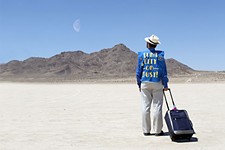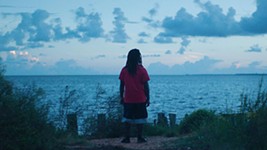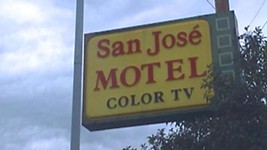L.A. Story
Documentary Goes Film Noir in Joseph Tovares' "Zoot Suit Riots"
By Anne S. Lewis, Fri., Jan. 11, 2002
![The kids that were convicted [in the Zoot Suit Riots] were not altar boys, says director Joseph Tovares. It was a very tough time in L.A. and, not all, but many were incredibly tough characters.](/imager/b/newfeature/84345/9008/screens_feature-12808.jpeg)
You'll be most pleasantly disappointed if you're expecting Joseph Tovares' Zoot Suit Riots to be another dry, medicinal history lesson. Instead, from the first frame, we're lowered into a racially tense City of Angels on a hot August night in 1942, wartime. The camera pans the tops of spindly palm trees silhouetted against a dusky royal blue sky; a moody clarinet whines, and the narrator's tone is slightly enervated but deadly serious. L.A. Confidential? Simmering just beneath the deceptively laid-back California surface is a flammable oil-and-water mix of 50,000 mostly white sailors restlessly awaiting their marching orders and neighborhoods of rebellious Mexican-American youth walking the streets dressed in in-your-face zoot suits. Can you say "doc-noir"?
In a film made for the PBS series American Experience, San Antonio native (now Boston resident) and UT Radio-Television-Film graduate Tovares tells the story of how a simple dust-up between Latino teens led to a party brawl, a death, and then an LAPD roundup of 600 Mexican-American kids. Of this group, 21 were indicted and 17 convicted. Convinced that justice had miscarried, a group of Hollywood celebrities, including Orson Welles and Rita Hayworth, along with members of the American Communist Party (the latter, explains Tovares, deployed by Party brass to "find another Scottsboro Boys in the West"), sprang to their legal defense. Racial tensions mounted, as did skirmishes between the men in uniform and the kids in zoot suits. On June 5, 1943, a bloody conflagration ignited and spun out of control over the next five days. At one point, 5,000 civilians jumped into the fray to assist the sailors, who by then had extended the target of their fury into the East L.A. barrios, beyond the zoot-suiters, to all Chicanos. Finally, the LAPD blew the whistle, ending the riots when it banned both servicemen and the wearing of zoot suits within city limits.
The Austin Chronicle: What, beyond the obvious drama, was it that attracted you to this particular chapter of history?
Joseph Tovares: This was a seminal event in Latino history without a serious documentary about it. It was attractive to me because it's loaded with gray areas -- not a white-guy/Chicano-victim kind of story -- but tough characters all around, a layering of complexity. Chicano mythology had it that these kids were completely innocent victims, lambs in a slaughter. Once I started researching, I found that, sure, these kids were victims, but they also organized and fought back -- they beat up a lot of sailors. The kids that were convicted were not altar boys. It was a very tough time in L.A. and, not all, but many were incredibly tough characters. Also, it was L.A. in the Forties, and this generation of kids was not really what the existing Chicano folklore would lead us to believe; they were very Americanized, very much wanted to be Americans, they embraced the jazz culture that existed in the city. It was really striking.
AC: We certainly see L.A. in a different light here, don't we?
JT: L.A. was going through enormous changes at that time; it was a truly unique time in its history. The city was crazy, it saw itself as the front line in the war with Japan, and it expected an attack from the Japanese at any moment. A lot of Mexican-Americans and blacks, too, were moving to L.A. at a time when there were lots of jobs. At the same time, large numbers of whites were leaving the city to join the Army. There was an incredibly strange change in dynamics as a result of this demographic shift. Add to this the fact that the Navy bases were often right in the barrios. The Chicano kids resented their presence, and the sailors often came from other parts of the country, like the South, and couldn't understand why Mexican kids didn't stay in their place. The level of antagonism that these Chicanos would heap on the servicemen was extraordinary. There was a strong level of animosity on both sides.
And, it was also obvious that the Chicano kids were really determined to separate and distance themselves from their parents, a generation that had been very quiet and very subservient. These kids were in-your-face, aggressive, very assertive kids of color, and that was very threatening. It's threatening now; I can't imagine how it wasn't threatening in the Forties.
AC: What were some of the technical hurdles you had to leap in order to tell this story? The reenactments you've done are really wonderful and evocative, but won't the doc purists cry foul?
JT: I am sure some will criticize me for the re-creations. Oddly enough, there was very little archival footage and only a few existing photos of this riot. There are elaborate conspiracy theories about why this is, but in terms of making this film, it meant that I had to rely upon re-creations. I tried, as a director, to maintain, in these reenactments, an impressionistic style -- using slow motion, and seldom showing people full-faced. There's a line that you cross with this device when it becomes hokey, not so believable anymore. It's very tricky to pull off, but I think I did -- everything takes place at night, there's a lot of fog, lots of lighting effects. All of this makes it more impressionistic, more believable, easier to enter this realm, and then people accept the archival material. You really need a lot of money -- which we didn't have -- to pull these off. People ask me, "How did you do the riots?" and my standard answer is "in close-up." We re-created the riot scenes using a total of eight actors (for both sides), and they were all Chicano actors, but you can't tell.
My goal was to do something really stylish, something that looked unlike the typical historical documentary. I wanted the film to have an upfront, just-shy-of-aggressive attitude, to reflect the attitude of the times. I think we succeeded. I think the film makes people feel uncomfortable, and I think it's important that it did. It's a very tough story.
AC: Was it hard to find the actual riot participants and get them to appear?
JT: Enormously. The sailors didn't want to talk about what they'd done. It took over a year to track down the two guys who did go on camera, and a lot of negotiation. The Mexican-Americans were easier to find, but not that easy. To find the sailors, we ran ads, set up 800 numbers, went to Navy reunion meetings, put ads in sailor reunion newsletters. We heard lots of horrific stories over the phone, but no one would agree to come on camera.
AC: What do you want us to conclude from your film?
JT: I want people to conclude that at times of war, otherwise good people do strange things. And, that at its core, this story is about race, a dominating issue in this country. It's a very L.A. story; it's a story in L.A. about race. People forget that 125 years ago, L.A. began as a small Mexican town. Over those years, there'd been an attempt to bury that fact. But now the Mexican-Latino presence has come back full force in L.A., so you can't bury it. But I think in the Forties, people thought the Mexican period hadn't existed, they thought of it as the old Spanish period.
What's really important is that this was a generation of kids who wanted to be American on their own terms, who thought they could get away with something different than their parents had. They learned a very difficult lesson, that L.A. in the Forties wasn't going to let them do it. It was a very tragic lesson. ![]()
Zoot Suit Riots will be presented as part of the Texas Documentary Tour on Wednesday, Jan. 16, 7:30pm, at the Alamo Drafthouse Downtown, 409 Colorado. Filmmaker Joseph Tovares will introduce the film and conduct a Q&A session following the screening. Advance tickets are available for Austin Film Society members only by calling 322-0145 or online at www.austinfilm.org/zoot. Tickets will go on sale at 6:15pm on the day of the show. Admission prices are $6 per show for the general public; $4 for Austin Film Society and KLRU members and students. The Texas Documentary Tour is a co-presentation of the Austin Film Society, the University of Texas RTF Dept., The Austin Chronicle, KLRU-TV, Hotel San José, and SXSW Film.










